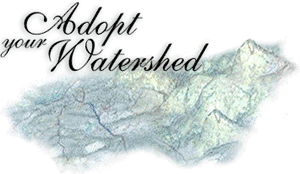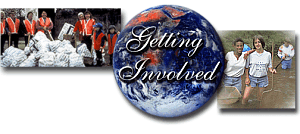Water: Adopt Your Watershed
Adopt Your Watershed

We all live in a watershed — the area that drains to a common waterway, such as a stream, lake, estuary, wetland, aquifer, or even the ocean — and our individual actions can directly affect it.

This video tutorial on Surf Your Watershed shows how to locate your watershed, learn about its health, and connect with local watershed groups through Adopt Your Watershed.
EPA's Adopt Your Watershed program challenges you to serve your community by taking part in activities to protect and restore your local watershed.
Visit our on-line Adopt Your Watershed database of more than 2,600 watershed groups to learn about opportunities to get involved in activities such as volunteer water monitoring, stream cleanups
![]() , and storm drain marking. Once you locate your watershed, simply click on "citizen-based groups at work in this watershed" to find a list of organizations.
, and storm drain marking. Once you locate your watershed, simply click on "citizen-based groups at work in this watershed" to find a list of organizations.
If you can't find a group to join or want to organize your own activity, we've included a Watershed Stewardship Toolkit with eight things you can do to make a difference in your watershed.
Add your watershed group to our searchable database of citizen-based watershed groups.
*The full Adopt Your Watershed database file is available as an XML file for download. (Right click and download to your computer. 2.2MB)
 Adopt Your Watershed is part of the President's UNITED WE SERVE initiative. Share your community service success story.
Adopt Your Watershed is part of the President's UNITED WE SERVE initiative. Share your community service success story.
What YOU Can Do to Make A Difference
A Watershed Stewardship Toolkit for Volunteers
-
Become a volunteer monitor. Monitor water quality conditions, build community awareness about water pollution, and help identify and restore problem sites. Visit our directory of volunteer monitoring programs or learn how to start out in volunteer monitoring.
-
Organize your own trash cleanup (PDF) (19 pp, 751K, About PDF)
 or join a nationwide river cleanup campaign (National Rivers Cleanup
or join a nationwide river cleanup campaign (National Rivers Cleanup
 ) or an international beach cleanup campaign (International Coastal Cleanup
) or an international beach cleanup campaign (International Coastal Cleanup
 ).
). -
Build a Rain Garden
 : Rain gardens planted with native vegetation help reduce the adverse effects of storm water runoff by soaking up excess rainwater.
: Rain gardens planted with native vegetation help reduce the adverse effects of storm water runoff by soaking up excess rainwater. -
Organize a Stream Drain Marking Project: Rain water that flows into storm drains goes untreated to nearby streams, lakes, and bays. Produce a flyer or door hanger to encourage pollution prevention. Visit EPA's Stormwater Web site for educational materials that can be downloaded or ordered for free.
-
Greenscape Your Yard: GreenScaping is a set of landscaping practices that can improve your lawn and garden while protecting and preserving natural resources.
-

-
Educate Your Community About Water Quality Protection: Use this collection of Public Service Announcements and downloads from effective advertising campaigns to raise awareness about water pollution and stormwater runoff.
-
Advocate for Low Impact Development in Your Community: Low Impact Development is an approach to land development (or re-development) that works with nature to manage the adverse impacts of storm water.
-
Start a Watershed Organization: If you are interested in starting your own watershed organization with partnerships, organizational priorities, a watershed plan and more, here are some things to consider before you get started.
See our Adopt Your Watershed Brochure (3 pp, 447K, About PDF)
Information presented in the Adopt Your Watershed database does not constitute an official endorsement by EPA of any particular group's policies, activities, or positions on federal or state legislation. Disclaimer.
